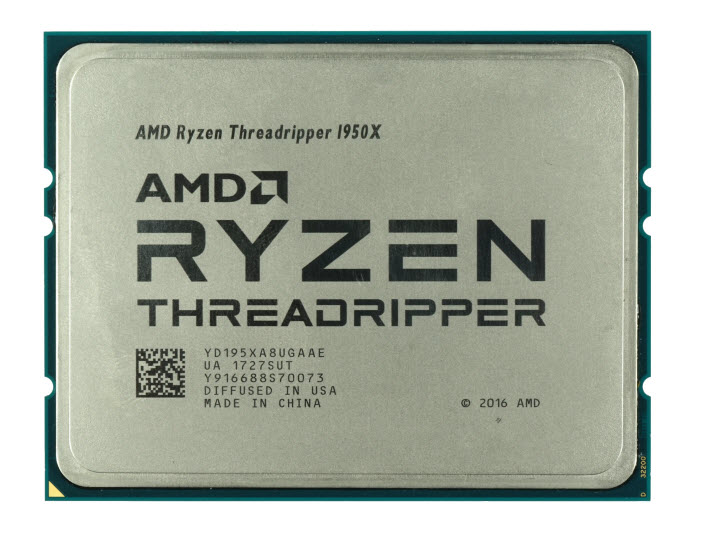10 Times AMD Beat Intel in the CPU Innovation Race
Five Decades of CPU Rivalry
AMD’s rivalry with Intel dates back five decades. The two processor manufacturers were born as rivals at the end of the 1960's, and they have continued their tug-of-war up to this very day. AMD, being the smaller competitor, has often been considered the underdog battling almighty Intel. Although history has shown us that it loves the underdogs, the last several years have arguably gone in Intel’s favor. However, the latest market data from reputable research firm Mercury Research revealed that AMD’s processor market share in the DIY segment has grown to 12% in the last quarter of 2017. Even though the Santa Clara-based chipmaker is back on track, it still has a long road to travel to end Intel’s dominance in the processor market.
Regardless of which side that you're rooting for, both AMD and Intel have had ups and downs over the years. Today, we're going to relive the times that AMD was able to beat Intel to the finish line by hitting a milestone first.
2000: AMD Athlon 1000 Wins The 1GHz Race
Back in an era where the majority of processors operated at a clock speed between 500MHz and 850MHz, AMD’s Athlon 1000 rose to fame when it became the first consumer desktop processor to reach the 1GHz landmark.
The Athlon 1000, codenamed “Magnolia,” was a single-core processor based on the K75 core. AMD produced its Athlon 1000 processors with the 0.18-micron manufacturing process, and it wielded over 22 million transistors. The 65-watt processor fitted perfectly into AMD’s (at the time) flagship socket-A motherboards and ran stable at 1GHz with a mere 1.80V.
2003: AMD Athlon 64 and 64 FX Set The Trend For Integrated Memory Controllers
AMD wasn’t the first company to release a processor with a built-in memory controller. That milestone belongs to Transmeta’s Crusoe family of microprocessors. However, AMD did beat Intel to implementing the concept into its processors. The Athlon 64 and Athlon 64 FX processors came with memory controllers integrated directly into the processors’ die. The presence of an integrated memory controller contributed to reducing latency for access requests to the system’s memory and enabled a performance increase.
Intel only adopted the use of integrated memory controllers in its processors when the chipmaker released its Nehalem architecture, five years later.
2003: AMD Athlon 64 Lays The Sledgehammer On Intel
Back in the old days, 64-bit processors were really exotic and very much limited to the workstation and server segments. AMD broke this mold by launching its Athlon 64 FX-51, the world’s first consumer x84 64-bit processor. The Athlon 64 FX-51, codenamed “Sledgehammer,” was a single-core processor clocked at 2.2GHz. AMD manufactured the processor with the company’s 0.13-micron Silicon-on-Insulator process.
Get Tom's Hardware's best news and in-depth reviews, straight to your inbox.
2004: AMD Opteron Paves The Way for Single-Die x86 Dual-Core Processors
As time progressed, computing tasks became more demanding and complex, which drove the need for faster processors. AMD knew two things back in 2004: Single-core processors will eventually hit a frequency wall, and you can only squeeze so much performance out of a single core. The answer was simple--add more processor cores to the die.
AMD introduced the world to its dual-core Opteron processor at the company’s Austin facility. Manufactured on the 90nm Silicon-on-Insulator process technology, the AMD Opteron was based on the 940-socket and packed two cores on the same die. The total number of transistors tallied to around 233 million.
2011: AMD FX-8150 Was Once The Fastest Processor On The Planet
Whether you’re a fan of Bulldozer architecture or not, there’s no denying that it enabled AMD to achieve a series of impressive firsts. Back in 2011, AMD was about to launch its Bulldozer-based FX desktop processors. However, the company’s eagerness to demonstrate Bulldozer’s power to the world got the better of it.
AMD assembled an elite team of overclocking specialists to push the FX-8150 to new heights. After many man hours, and tanks of liquid nitrogen and helium later, the team was able to overclock the FX-8150 to a remarkable frequency of 8429MHz. The Guinness World Record organization awarded AMD with the "Highest Frequency of a Computer Processor" record, which it holds to this day.
2011: AMD FX-8150 Bulldozes Everything In Its Sight
AMD’s performance war with rival chipmaker Intel gradually evolved from who had the processor with the highest frequency to who has the most cores. With the introduction of the FX-8150 processor, we witnessed the world’s first retail octa-core processor. The 125W processor had a base clock of 3.6GHz but could boost up to 4.2GHz. GlobalFoundries produced it on the company’s 32nm Silicon-On-Insulator manufacturing process. The FX-8150 had approximately 1.2 billion transistors.
2011: AMD APU Makes Gaming On Integrated Graphics A Reality
While processors with integrated graphics already existed before AMD introduced its Accelerated Processing Unit (APU), you couldn’t really game on them--at least not in at an enjoyable frame rate and resolution. Llano, the first generation of APUs, featured models from two to four cores based on the Radeon HD6000 Series graphics. While the APUs were certainly better than rival processors with integrated graphics, their CPU performance weren’t exactly exciting. Fast forward to 2017, and AMD’s current generation Raven Ridge APUs (like the Ryzen 5 2400G) can provide a solid gaming performance at 720p and an acceptable level of performance at 1080p with the right settings.
2013: AMD FX-9590 Takes Home The 5GHz Crown
In 2013, AMD ushered in its FX-9590 processor to beat Intel in the gigahertz race once again. The FX-9590 shipped with a base clock of 4.7GHz but had a turbo clock of 5GHz that allowed it to take the crown of the first commercial processor to reach 5GHz. Intel just hit that mark with the Core i7-8086K five years later. However, taming AMD's eight-core monster was certainly not an easy task. With a TDP in the range of 220W, only a limited number of motherboards could handle the beast, and liquid-cooling suddenly became a necessity instead of a luxury.
Credit: B&H
2013: Temash and Kabini APUs Grab World's First x86 Quad-Core SoC Title
Competition in the tablet and hybrid notebook markets was extremely thin in 2013. The majority of the products on the market used ARM mobile processors. During CES of that year, AMD revealed its Jaguar-based Temash and Kabini APUs that became the world’s first x86 quad-core systems-on-a-chip (SoC).
The Temash line featured dual-core and quad-core APUs clocked at 1GHz, with a TDP of 4W and 8W, respectively. Given the low TDP, the Temash APUs focused predominantly on Windows 8 tablets and hybrid notebooks. On the other hand, the Kabini APUs came in dual-core and quad-core models with clock rates that range from 1GHz all the way up to 2.2GHz. As a result, the TDP is also higher: The lowest dual-core model consumed 9W, and the highest-end part drew 25W. The Kabini line of APUs was used in ultra-thin notebooks.
2017: AMD Ryzen Threadripper 1950X Leads The Way To More Cores For HEDT Processors
AMD made many headlines last year when it came out with the world’s first 16-core consumer processor. The Ryzen Threadripper 1950X is a silicon monster, with its 16 cores and 32 threads of high-performance processing power. The processor is based on the Zen microarchitecture, and fabricated on the 14nm process. The Threadripper 1950X runs at a base clock of 3.4GHz and can boost up to 4GHz. It has a 180W TDP and comes with features such as support for four DDR4 memory channels and 64 PCIe Gen 3.0 lanes.

Zhiye Liu is a news editor, memory reviewer, and SSD tester at Tom’s Hardware. Although he loves everything that’s hardware, he has a soft spot for CPUs, GPUs, and RAM.
-
salgado18 AMD has beaten Intel a lot of times. But evil tactics from Intel and one bad generation from AMD made the first rest on its laurels, and the later to go nearly bankrupt.Reply
But AMD has always been about inovation, like it or not. -
jeremyj_83 The first Athlon at 1GHz was based on the K75 core not Thunderbird. It was a Slot A processor with 1/3 clock rate L2 cache.Reply -
Onus I'm no Intel fanboy, but this article is really reaching. Highest clocks <> fastest processor, and Bulldozer was often called Faildozer for Reasons.Reply
Today, a suitable PC for most any task (not requiring Big Iron) can be built with a CPU from either company. -
bloodroses Being first doesn't necessarily mean being better as software needs to be there as well to take advantage of it. AMD takes risks to try and stay competitive, Intel stays with the standard. the 64-bit CPU is a perfect example as while AMD may have hit 64-bit first with x86, 64-bit Windows didn't become viable until Intel joined the game as well. Anyone who ran the 64-bit version of Windows XP on their new AMD chip knows this very well.Reply
Regardless, if it wasn't for AMD, innovation would stagnant as Intel wouldn't have actual competition in the x86 space. -
Martell1977 I'm surprised there is no mention of the period when AMD was spanking Intel on IPC. In the time of 1.2ghz to 2.2ghz, AMD CPu's were killing Intel's P4. They had CPU's at 1.4ghz that were equivalent to Intel's 1.7 or 2.0ghz P4's.Reply -
Gam3r01 Reply21099678 said:I'm no Intel fanboy, but this article is really reaching. Highest clocks <> fastest processor, and Bulldozer was often called Faildozer for Reasons.
Today, a suitable PC for most any task (not requiring Big Iron) can be built with a CPU from either company.
Im assuming we are supposed to read this article as a time based measure, not performance based. They beat them to that milestone, but failed to surpass intel with it. Which is not a great metric, but its something I guess. -
jimmysmitty Reply21099814 said:21099678 said:I'm no Intel fanboy, but this article is really reaching. Highest clocks <> fastest processor, and Bulldozer was often called Faildozer for Reasons.
Today, a suitable PC for most any task (not requiring Big Iron) can be built with a CPU from either company.
Im assuming we are supposed to read this article as a time based measure, not performance based. They beat them to that milestone, but failed to surpass intel with it. Which is not a great metric, but its something I guess.
Than I would say how is that innovation? What good was a 5GHz FX-9590 that often couldn't stay at 5GHz without a decent CLC and even then failed to beat most stock clocked i5s?
IMC, sure. Dual core, yes. But some of these are not what I would call innovation. -
almarcy Us geezers are amused by the state of the art... when I started, Univac still had in service computers using vacuum tubes. When the world went all SS, "Binning" of transistors was done by their switching speed. A given crop of theoretically similar pieces would require up to twenty bins. Ah, the good old days. Mainframes had vast back panels that sported huge coils of simple wire to get them all to work together, for a while. It was more fun, back when a system crash meant the user population could go home and call in daily to see if it was back up. I remember being at an IBM site that had crashed and stayed down over a week. Lots of three piece suits walking around, trying to look serious.Reply -
gasaraki This article is reaching... Could have listed other things. Can't believe Bulldozer and FX is on here...Reply










